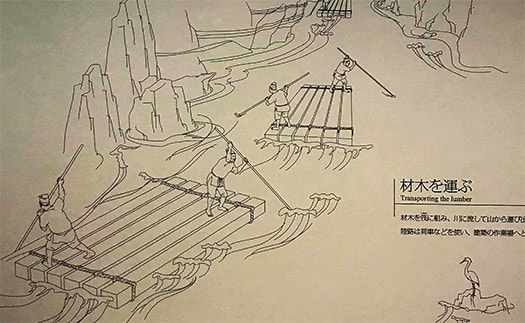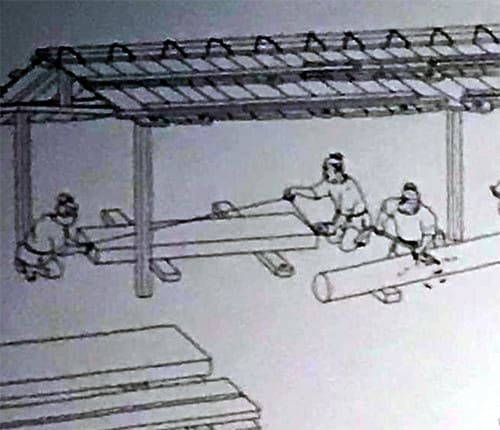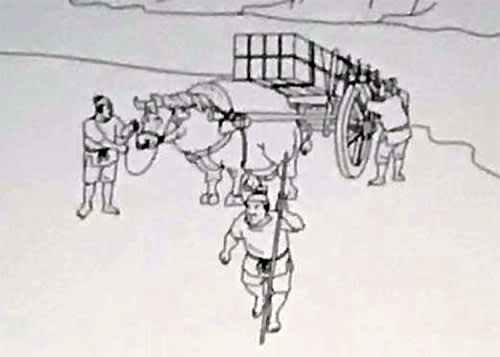




木を扱う、利用するという営為は人類史の中でもかなり枢要だと思える。
人類が進出した世界同時多発的にこうした技術進化は進んだだろうけれど、
四季変化があり、多量の降雨で豊かな森林を維持する極東アジアの列島は
木造技術進化において稀有な諸条件を満たしていたと思われる。
ヨーロッパに向かった人類集団は石による建築文化が優先したとも思えるし、
土にこだわった建築文化を生み出したりもした。
一方で文明段階が進んでいく毎にそれら相互間での技術交流も活発化しただろう。
しかし、日本オリジナルの木の文化はマザーのように深く刻印もされている。
竹中大工道具館展示での地味なイラスト展示シリーズですが、
なかなかモノとしてのエビデンスが残りにくい営為だけれど
しかしそれが決定的だったことについて表現して行くには
こういった「公知」を明示する必要はあると思います。
きっと展示担当者も相当にエビデンス探しを行っただろうけれど、
そもそもその工具、道具も初源のカタチが失われてもいる。あとで触れるが、
法隆寺宮大工だった西岡常一氏は初源の大工手仕事の復元にこだわり
ヤリカンナなどの失われた道具を復刻させたりしたという。
人類進化のプロセスをカタチにして遺すのは技術発展の基盤を守る意味でも
非常に重要だと思う。失われてから大事さがわかってくる事柄。
原木を伐採し、打ち割り製材して現地である程度加工を加えた材木を
豊富な河川交通を利用して建築利用地に運んで来る作業。
現代ではこういった機能は世界中から商社が果たして、
建築現場ではその出産地のことを想像することも少なくなったけれど、
初源期の建築営為では、まさに「どこから用材を切り出すか、いつ切るか」
ということもきわめて重要なファクターだったに違いない。
とくに三内丸山にしろ、出雲神殿にしろ「巨木」への帰依が感じられる日本では
太く高い原木への探究心が強かったに違いない。
出雲では神話のように、巨木用材が流木として流れ着いたという伝承がある。
その数、数百本と語られている。そういうことが「たまたま」起こることはない。
それは相当遠隔地から利用する用材を調達し、出雲の浜に運び入れたのでしょう。
その様子を宗教施設として語り伝える意味で神話化したに違いない。
陸上輸送ではコロの原理で巨木材を運んだだろうことが推定される。
戦国期の安土城建築では「修羅」巨大運搬具もジオラマ展示されていたけれど、
牛車というような重量物運搬具も、その初源を知りたくなってくる。
重量物を運ぶには「道路」も整備される必要があるけれど、
列島居住初源期、三内丸山縄文段階では、あの巨木をどう「移動」させたか、
地盤というものを見抜く知見も存在したのでしょう。・・・
この列島社会でどんな木造技術進化が生起したのか、
探査していく工程には尽きせぬ先人たちの知恵と工夫が存在しているのでしょう。
English version⬇
[History of lumbering and transportation in archipelago society / Good Japanese house ㊳-7]
The act of handling and using trees seems to be quite important in human history.
Although such technological evolution would have progressed at the same time in the world where human beings have advanced,
The archipelago of Far East Asia, which has four seasons and maintains abundant forests with heavy rainfall
It seems that it met rare conditions in the evolution of wooden technology.
It seems that the stone architectural culture was prioritized for the human group heading to Europe.
I also created an architectural culture that was particular about the soil.
On the other hand, as the civilization stage progressed, technological exchanges between them would have become more active.
However, the original Japanese wood culture is deeply engraved like a mother.
This is a series of sober illustrations exhibited at the Takenaka Carpentry Tools Museum.
It's an activity where evidence as a thing is hard to remain
But to express that it was decisive
I think it is necessary to clearly indicate such "public information".
I'm sure the person in charge of the exhibition would have searched for evidence, but
In the first place, the original shape of the tools and tools has been lost. I will touch on it later
Tsunekazu Nishioka, who was a carpenter at Horyuji Temple, is particular about restoring the original carpenter's handiwork.
He is said to have reprinted lost tools such as Yarikanna.
Leaving the process of human evolution in shape also means protecting the foundation of technological development.
I think it's very important. Things that become important after being lost.
Logs are cut down, sawn by splitting, and processed locally to some extent.
Work to bring to the construction site using abundant river traffic.
Today, trading companies from all over the world perform these functions.
At the construction site, I rarely imagine the place of birth,
In the construction business in the early days, it is exactly "where to cut the lumber and when to cut it".
That must have been a very important factor.
Especially in Japan where you can feel the devotion to "giant trees" whether it is Sannai Maruyama or Izumo Temple.
He must have had a strong quest for thick and tall logs.
In Izumo, as in mythology, there is a tradition that giant wood lumber has drifted as driftwood.
It is said that there are hundreds of them. That doesn't happen "by chance".
It must have procured materials for use from a considerable remote area and brought them to the beach of Izumo.
It must have become a myth in the sense that it tells the situation as a religious facility.
It is presumed that in land transportation, huge timber would have been carried by the principle of rollers.
In the Azuchi castle architecture during the Warring States period, a diorama of "Shura" giant carrier was also exhibited.
You will want to know the origin of heavy goods carriers such as ox carts.
"Roads" need to be maintained to carry heavy objects,
How did you "move" that giant tree during the Jomon period of Sannai Maruyama, the first source of residence in the archipelago?
Perhaps there was also knowledge to see through the ground.・ ・ ・
What kind of wooden technology evolution has occurred in this archipelago society?
There must be inexhaustible wisdom and ingenuity of our predecessors in the exploration process.



















